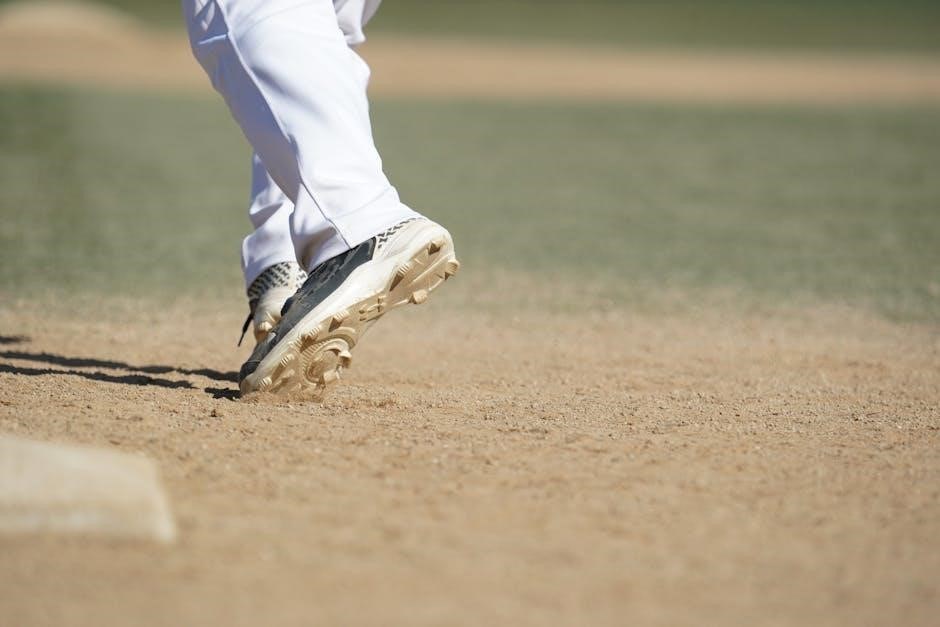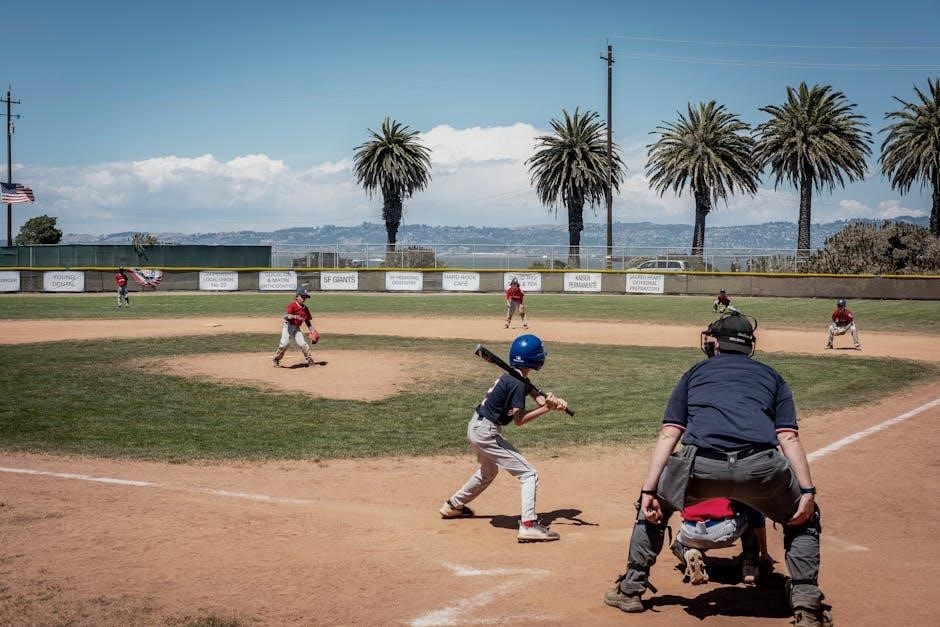The third base coach is pivotal in directing runners and batters through hand signals, decoy signs, and verbal cues, ensuring strategic execution and preventing opponents from anticipating plays.
1.1 The Role of the Third Base Coach in Baseball
The third base coach plays a critical role in a team’s offensive strategy, acting as the final relay for signals from the dugout to runners and batters. They are responsible for directing runners on whether to advance, hold, or attempt a steal, using a combination of hand signals, verbal cues, and decoy signs. The coach must make split-second decisions, considering factors like the game situation, runner speed, and pitcher tendencies. Additionally, they must stay within the coach’s box during play but can move down the line to guide runners approaching home plate. Their ability to communicate clearly and strategically is vital to the team’s success.
1.2 The Importance of Signals in Baseball Strategy
Signals are the backbone of baseball strategy, enabling seamless communication between coaches, runners, and batters. They allow teams to execute plays like steals, sacrifices, and holds effectively. The third base coach’s signals ensure runners make informed decisions, maximizing scoring opportunities while minimizing outs. Clear and consistent signals prevent confusion and ensure all players are on the same page. Teams that master their signal systems gain a competitive edge, as opponents struggle to anticipate their moves. Effective signaling requires precision, adaptability, and trust among players and coaches, making it a cornerstone of successful baseball strategy at all levels of the game.

Essential Signals Used by Third Base Coaches
Third base coaches use hand signals, body indicators, and voice commands to direct runners and batters. These signals include stops, goes, steals, and decoys to outsmart opponents effectively.
2.1 Basic Stop and Go Signals
The third base coach uses fundamental signals to guide runners. A stop sign typically involves raising both hands above the head, signaling the runner to halt at the base. Conversely, a go signal, often a windmill motion with one arm, directs the runner to advance. These signals are clear and concise, ensuring quick decision-making. Verbal cues, like “hold” or “go,” often accompany hand signals for added clarity. Proper execution of these signals is crucial, as they directly impact the runner’s actions and the team’s strategic outcomes during the game.
2.2 Hand Signals for Stealing Bases
Third base coaches use specific hand signals to indicate base-stealing opportunities. A common signal is brushing the hand against the sleeve, signaling the runner to attempt a steal. Other signals may involve touching specific body parts, like the hat or belt, to convey the message. These signals must be quick and subtle to avoid detection by the opposing team. Runners are trained to recognize these cues instantly, allowing them to react decisively. The coach’s timing and positioning are critical, as they must assess the pitcher’s focus and the catcher’s readiness to throw. Successful execution relies on clear communication and precise timing.
2.3 Decoy Signals to Deceive Opponents
Decoy signals are essential tools for third base coaches to mislead opposing teams. By using fake hand gestures or unnecessary body movements, coaches can disguise their true intentions. For example, a coach might pretend to signal a steal but instead be setting up a bunt. These deceptive tactics force the opposing team to remain vigilant, preventing them from anticipating actual plays. Effective decoy signals require coordination with the team and precise execution to maintain credibility. Overuse, however, can lead to suspicion, so coaches must balance deception with genuine signals to keep opponents guessing and maintain strategic advantage.
Situational Strategies for Third Base Coaches
Third base coaches must adapt strategies based on game situations, such as runner speed, outfield positioning, and score margins, to maximize scoring opportunities while minimizing risks.
3.1 When to Send a Runner Home
Third base coaches decide to send runners home based on factors like the game score, runner speed, and outfielders’ positioning. They use stop or go signals to guide runners, ensuring they reach home plate safely without being tagged out. Coaches must quickly assess the situation, considering the risk of an out versus the potential score. Verbal cues and hand signals are critical for clear communication. Proper timing and judgment are essential to make split-second decisions that maximize scoring opportunities while minimizing risks.
3.2 When to Hold a Runner at Third Base
Third base coaches must decide when to hold a runner at third base to avoid potential outs. This decision often depends on the outfielder’s position, the strength of their arm, and the game situation. Coaches use a hold signal, such as raising both arms, to instruct the runner to stay. They consider factors like the score, inning, and runner’s speed. Holding prevents unnecessary risks, especially with less experienced players. Verbal cues and clear hand signals ensure the runner understands the instruction instantly. Proper timing and judgment are key to balancing aggression and caution, ensuring the runner’s safety and maximizing scoring opportunities.
3.3 Signaling for Sacrifice Flies
Third base coaches use distinct signals to indicate a sacrifice fly, often involving a diagonal swipe of the arm or a touch to the cap. These signals, combined with verbal cues, instruct the batter to hit the ball deep, allowing the runner to score. The coach assesses the outfielder’s position and the game situation to determine if a sacrifice fly is strategic. Timing is crucial, typically with less than two outs and a runner in scoring position. Clear communication ensures the batter and runner execute the play effectively, maximizing scoring opportunities while minimizing risks. Accurate signaling is vital for the success of this offensive strategy.
How Signals Are Relayed
Third base coaches relay signals through hand gestures, body movements, and verbal cues to communicate strategies to runners and batters. These signals must be clear and quick to prevent opponents from interpreting them, ensuring effective execution of offensive plays during the game.
4.1 Signals to Runners on Base
Third base coaches use a combination of hand signals and verbal cues to guide runners on base. These signals must be clear and easily understandable to ensure runners make the right decisions. Common signals include holding both arms up for “hold” and using a windmill motion for “go.” Coaches may also use decoy signals to confuse opponents. Runners must stay alert and trust the coach’s instructions, especially in high-pressure situations. Effective communication is crucial to execute plays successfully and avoid misinterpretations. Coaches often position themselves strategically to relay signals accurately, ensuring runners respond appropriately during the game.
4.2 Signals to the Batter at Home Plate
Third base coaches also relay signals to the batter at home plate, coordinating offensive strategies. These signals are often subtle, using hand gestures or body parts like touching the hat or belt. The coach may flash a series of signs, with the first being an indicator to watch closely. The batter must quickly interpret these cues to execute plays like bunts or steals. Verbal commands may accompany hand signals for clarity. Coaches ensure signals are distinct to avoid confusion, helping the batter make split-second decisions. This communication is critical for aligning the batter’s actions with the team’s strategic goals during the game.
Advanced Techniques in Signal Execution
Advanced techniques include using body parts as indicators, combining hand and voice commands, and employing decoy signals to confuse opponents while maintaining clear communication with runners and batters.
5.1 Using Body Parts as Indicators
Third base coaches often use specific body parts to signal plays, such as touching their hat, belt, or elbow. These subtle gestures indicate actions like steals or bunts, keeping strategies hidden from opponents. For example, a coach might touch their cap to signal a bunt or brush their sleeve to indicate a steal. This method ensures clarity for runners while maintaining deception. Coaches must consistently practice these signals with players to avoid confusion and ensure quick execution during games. Effective use of body indicators enhances teamwork and strategic play execution on the field.
5.2 Combining Hand and Voice Commands
Third base coaches often combine hand signals with verbal cues to ensure clear communication. For example, a coach might use a hand gesture to indicate a steal, followed by a verbal command like “Go!” to execute the play. This dual approach helps prevent misinterpretation, especially in noisy environments. Coaches may also use voice commands to reinforce hand signals, such as shouting “Hold!” to stop a runner. The combination of visual and auditory cues enhances clarity and ensures runners and batters respond quickly. Consistent practice of these combined signals is crucial for effective teamwork and strategic execution during games.

The Process of Creating a Signal System
Creating a signal system involves collaboration between coaches, balancing complexity and simplicity, testing effectiveness, and ensuring consistency to maintain clarity and prevent miscommunication during games.
6.1 Developing a Unique Set of Signals
Developing a unique set of signals requires creativity and collaboration with the team. Coaches often combine hand gestures, body parts, and verbal cues to create a system that is both complex and clear. Signals must be distinct to avoid confusion and should align with the team’s strategic goals. Involving players in the process ensures understanding and execution. Testing the system during drills and refining it based on feedback is crucial. While complexity can enhance effectiveness, simplicity is key to prevent misinterpretation. A well-designed signal system fosters trust and precision, giving the team a competitive edge while keeping opponents guessing.
6.2 Ensuring Team Understanding and Execution
Effective execution of signals hinges on clear communication and consistent practice. Coaches must ensure players understand each gesture, verbal cue, and contextual application. Regular drills and pre-game warm-ups help reinforce signal recognition and reaction. Players should be encouraged to ask questions and seek clarification to avoid confusion. Using visual reminders, like wristbands with key signals, can aid memory. Trust between runners and coaches is crucial, as hesitation can lead to missed opportunities. Real-time adjustments during games, based on situational awareness, further enhance execution. Feedback after games helps refine the system, ensuring alignment and precision in future performances.

Common Mistakes to Avoid
Overcomplicating signals and failing to adapt during games can confuse runners and opponents. Consistency and simplicity are key to effective communication and execution.
7.1 Overcomplicating Signal Systems
One common mistake is overcomplicating signal systems, which can confuse runners and opponents. Simple, consistent signals are more effective than intricate ones. Coaches should avoid using too many gestures or combining signals unnecessarily, as this can lead to misinterpretation. Overly complex systems increase the risk of errors, such as base runners misreading signs or hesitating. This confusion can also alert opposing teams to potential strategies. To avoid this, coaches should stick to basic, easily recognizable signals and ensure all players understand them through practice and repetition. Simplicity and clarity are key to successful signal execution in baseball. Avoid unnecessary complexity to maintain effectiveness.
7.2 Failing to Adapt Signals During Games
Failing to adapt signals during games is a critical mistake. Opponents often decode signals as the game progresses, rendering them ineffective. Coaches must remain vigilant and adjust signals based on the game’s flow and opponent awareness. Static signal systems allow opposing teams to anticipate strategies, reducing their impact. To combat this, coaches should incorporate decoy signals and modify indicators dynamically. Regularly changing signals keeps opponents guessing and maintains a strategic edge. Flexibility and adaptability are essential for sustained success in baseball signaling. Coaches must continuously evolve their approach to stay ahead of opposing teams’ defenses and strategies.

The Role of Technology in Modern Signal Systems
Technology enhances baseball signal systems through wristbands and apps, allowing coaches to communicate strategies discreetly. Digital tools streamline signal planning and execution, reducing opponent decoding risks.
8.1 Using Wristbands for Signal Indicators
Wristbands have become a modern tool for baseball coaches to convey signals discreetly. Players wear these bands on their forearms or attach them to their belts, featuring numbered codes that correspond to specific plays. Coaches call out numbers, and players quickly reference their wristbands to execute the strategy. This system minimizes the risk of opponents decoding signals, as the numbers are unique to each team. Wristbands are particularly useful for relaying complex instructions without overt hand gestures, ensuring seamless communication and maintaining a strategic edge in competitive games. They’ve become an essential part of modern baseball’s signal systems.
8.2 Apps and Digital Tools for Signal Planning
Digital tools and apps have revolutionized how baseball teams plan and execute signals. Coaches can now design custom signal systems using software, creating unique codes and sequences that are harder for opponents to decipher. These apps often include features like encryption, ensuring signals remain confidential. They also allow for real-time updates during games, enabling coaches to adjust strategies instantly. Players and coaches can access these systems via mobile devices, streamlining communication. Digital tools not only enhance organization but also provide a modern, efficient way to manage the complexities of baseball signaling, keeping teams ahead in competitive play.
Coaching Tips for Effective Signal Communication
Consistency, clear gestures, and verbal cues are key. Practice drills to ensure players recognize signals instantly, fostering seamless communication and strategic execution during games.
9.1 Practicing Signals During Drills
Effective signal communication begins with rigorous practice during drills. Coaches should simulate game scenarios to teach runners and batters how to recognize and react to signals instantly. Start with basic drills, such as stop-and-go signals, to build familiarity. Use repetition to ensure players can distinguish between decoy and actual signals. Incorporate verbal cues alongside hand gestures to reinforce understanding. For example, a windmill motion might signal a steal, while raised arms indicate a hold. Coaches should provide immediate feedback, correcting misunderstandings and ensuring clarity. Consistent practice fosters trust and precision, enabling seamless execution during live games.
9.2 Maintaining Consistency in Signal Usage
Consistency is key to effective signal communication. Coaches must use the same signals repeatedly to avoid confusion. Players rely on recognizing patterns quickly, so any deviation can lead to misinterpretation. Establish a standardized system of hand gestures, decoy signs, and verbal cues, ensuring all team members are well-versed. For instance, a specific touch to the cap might always mean a bunt, while a swipe of the arm signals a steal. Regular drills and reviews reinforce this consistency, ensuring every player reacts appropriately. Over time, this uniformity becomes second nature, enhancing teamwork and strategic execution during games.
Case Studies of Successful Signal Strategies
Professional teams like the Chicago Cubs and Boston Red Sox have demonstrated how effective signal strategies can lead to game-winning plays. For example, during the 2016 World Series, the Cubs’ third base coach used a series of decoy signs to confuse the opposition, leading to a crucial stolen base. These case studies highlight the importance of clear communication and strategic signaling in achieving victory.
10.1 Examples from Professional Teams
Professional teams like the Chicago Cubs and Boston Red Sox have showcased masterful use of third base coach signals. For instance, the Cubs’ third base coach during the 2016 World Series used a series of decoy signs to confuse the opposition, leading to a crucial stolen base. Similarly, the Red Sox have employed complex hand signals to relay stolen base attempts and sacrifice flies. These examples highlight how precise communication and strategic signaling can directly impact game outcomes. Teams often adapt their systems to outsmart opponents, demonstrating the evolution of signal strategies in modern baseball.
10.2 Learning from Historical Games
Historical games offer valuable insights into the evolution and effectiveness of third base coach signals. For example, the 2016 World Series showcased the Cubs’ third base coach using decoy signs to confuse opponents, leading to a pivotal stolen base. Similarly, the Boston Red Sox have historically employed intricate hand signals to relay strategies during critical moments. By studying these historical examples, modern coaches and players can gain a deeper understanding of how to adapt and refine their signaling techniques. These lessons highlight the importance of strategic communication in shaping game outcomes and influencing future baseball strategies.
The third base coach’s signals are integral to baseball strategy, blending tradition with innovation to guide runners and batters effectively, ensuring dynamic and successful gameplay.
11.1 The Evolution of Third Base Coach Signals
Third base coach signals have evolved significantly, from basic hand gestures to sophisticated systems incorporating wristbands and digital tools. Initially, simple stop and go signs were used, but modern strategies now blend traditional methods with technology for enhanced communication. The integration of apps and wearable devices ensures faster and more discreet signaling, reducing the risk of opponents deciphering them. This progression reflects baseball’s adaptation to technological advancements while maintaining the essence of strategic communication. The evolution underscores the coach’s critical role in dynamically guiding players, ensuring effective teamwork and tactical execution on the field;
11.2 The Future of Signal Systems in Baseball
The future of signal systems in baseball is expected to integrate advanced technology, enhancing communication between coaches and players. Wristbands with digital displays and encrypted apps could become standard, allowing for faster, more secure signaling. These tools would minimize the risk of opponents decoding signals, ensuring strategic advantages. Additionally, AI-driven systems might analyze game situations in real-time, suggesting optimal plays. However, the core principles of clear, precise communication will remain essential. As technology evolves, baseball will likely see a blend of traditional hand signals and innovative digital methods, ensuring the game stays strategically dynamic while embracing modern advancements.
